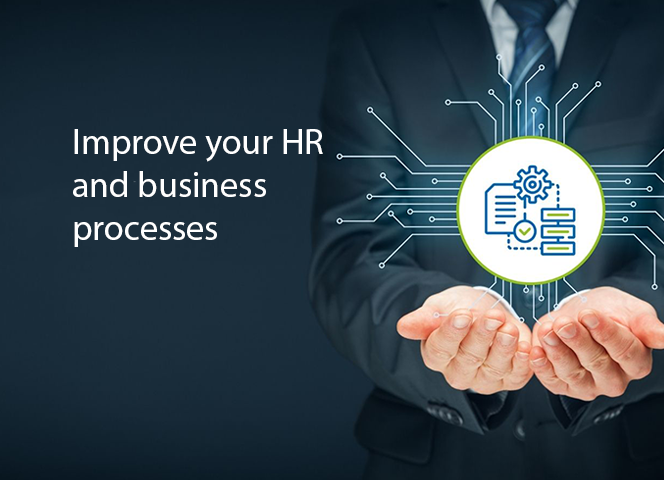When it comes to system and cultural changes, HR has a major role to play. A lot has been written recently about HR and the significant role it has to play in the success of every business, but yet many HR processes are still manual and highly ineffective. With the rise of HR technologies, HR is slowly realising the power of digital and the benefits of the built-in automation that most systems offer (e.g. manager holiday approvals, notifications of performance reviews, anniversary reminders, etc.). They will also recognise that many other HR and business systems could benefit from data held in the core HR system, and this is where HR Automation comes to the fore.
HR is becoming a strategic partner that contributes to bottom-line business results — and it must evolve from a cost centre to a profit centre. As a result, HR has an excellent opportunity to support their company’s digital agenda while shifting its own digital transformation into overdrive. In particular, cloud-based computing, collaboration technologies, and digitisation of processes, resources, and content will be significant areas of focus throughout the business.
A recent survey of 2,000 office workers by a robotic process automation (RPA) software company found that respondents reported wasting 4 hours, 59 minutes every week on activities they say could be automated.
HR needs to align themselves to the company’s priorities, which a recent survey highlighted as the following:

What is HR Automation?
HR Automation automates certain processes and therefore increases productivity and effectiveness. Certain manual tasks can be administered by smart technology. This technology will use predetermined triggers to manage tasks, which would typically be manual ad hoc tasks performed by HR staff. Ensuring that these tasks are completed accurately and in a timely manner will help businesses be more productive, streamlined and base their decisions on accurate and up-to-date data.
Typical terms used in HR Automation and what they mean:
- RPA – Robotic process automation (RPA) is about using ‘robots’ to handle repetitive, rule-based digital tasks much like human workers do.
- BOT – The robot referred to in RPA is a form of intelligent software to automate processes. A basic example of a bot might be an Internet search engine’s spiders – little pieces of software code that trawl websites to update search engine indexes.
- Machine Learning – Machine learning, a critical arm of artificial intelligence (AI), is a self-learning algorithm that uses data and statistical models to perform a task without being given specific instructions each time. Instead, it finds patterns in data and learns from these patterns to make future predictions based on these patterns. The software powered by machine learning is fed algorithms to interpret data.
- Artificial Intelligence (AI) – At a high level, artificial intelligence (AI) is a technology that allows computers to learn from and make or recommend actions based on previously collected data. Artificial intelligence can be applied in many different ways to streamline processes and improve efficiency in human resources management.
- Chatbots – A virtual assistant that responds to employees’ requests in real-time, based on a pre-set questions and on the answers entered by the respondent.
- Virtual Reality (VR) – VR for training is often referred to as “immersive training”. It combines virtual reality with advanced learning theory, data science and spatial design.
- Application Programming Interface (API) – API is a series of rules and protocols that helps systems fetch data and data points from other systems. An effective API will make the integration of two computer systems seamlessly talk to each other, as it will have all necessary building blocks put together by the computer programmer.
What can typically be automated?
The best-in-breed HR System will automate many tasks, including notifying the relevant recruiting manager or HR when a new employee has completed their onboarding form and informing a training administrator when a learner has completed an assigned course.
When a company uses various business systems to manage the specific disciplines (IT, Marketing, Sales, Finance, HR, Training, Recruitment, etc.), many of the systems operate in isolation. For instance, when IT needs to update their systems (Active Directory) with starters, leavers, and other changes. This is typically done manually when the responsible administrator finds the time to complete the task. With HR Automation, the two systems could be set up to “talk” to each other. Then, when a change is made to the HR system (the “trigger”), the Active Directory is automatically updated with the latest changes. That way, access to the relevant IT systems will be guaranteed and completed in a timely fashion.
Another example is ensuring that critical HR data (headcount, vacancies, salaries, skills, etc.) is fed into the company’s business intelligence tool (e.g. PowerBI, Tableau, SAP BI, IBM Cognos, etc.) to help with real-time, accurate business planning and decision making.
For more examples of what typically HR processes can be automated, follow this link: HR Automation – Tugela People
What are the benefits of HR Automation?
The business benefits of automating HR processes are endless. Besides the many hours saved in completing repetitive tasks of updating or transferring data manually, there are the added benefits of ensuring the right (& accurate) data is in the right system in a timely fashion (real-time).
In short, the main benefits of implementing effective HR Automation are:
- Overall improvement of HR and business processes.
- Vastly improved employee engagement – Employees want to work on items requiring creativity, collaboration and strategic thinking. Performance and employee experience improves dramatically when employees can leverage automation.
- Accurate, real-time data, which leads to better data-driven decision making.
- Effective data management – Master data is transferred to other systems when required and therefore only entered once.
- Better use of resources as they are freed up from repetitive, manual tasks.
- Avoid data silos and have a clear understanding of which system is the primary source of what data.
- 24/7 employee access to data and information.
- Scalability and futureproofing as systems can be integrated quickly and process adapted to ever-changing business needs
Identifying specific HR processes to prioritise use cases for RPA relevance is crucial to leverage automation across the HR function. For this, DRAUP analysed 100+ HR activities across functions such as HR Strategy, Talent Acquisition, Compensation & Benefits, HR Operations, etc. Among these, 30 HR processes were shortlisted, bucketed across 6 HR functions to create a use case prioritisations framework:

While many HR organisations have piloted certain emerging technologies – including robotic process automation and virtual assistants/chatbots – broad adoption remains limited. HR respondents, however, predict moderate to strong growth of these tools in 2021

Uipath has produced this infographic of the results of one client from automating four processes:

What is involved in HR Automation?
According to Convedo, the following nine steps provide a guide for organisations looking to harness the power of RPA for their business processes:
- Define Your Objectives
Creating a blueprint first requires you to speak to the primary stakeholders about what they want from the project. For example, the training manager may want the LMS to be up to date with new starters, leavers and changes to current employees details? That way, the LMS learner data would be derived from the primary data source held in the HRIS (the desired outcome/goal)
- Find Opportunities
Once you have a clear sense of what you hope to accomplish, begin assessing which of your processes are strong potential candidates for RPA. Some of the crucial factors to look out for include:
- Processes using high volumes of data
- Processes recurring frequently
- Repetitive processes
- Processes requiring a high degree of accuracy (and that machines can do better than humans)
- Validate Your Beliefs
Of course, after identifying processes for automation, you then need to analyse them to find the best options. Bring together a team of subject matter experts (SME) who are familiar with the processes and RPA.
- Establish Governance
If you plan to incorporate RPA as a long-term part of your HR strategy, it should be aligned with your broader business objectives and initiatives.
- Develop a Plan
Any organisation looking to implement RPA should have a formal document describing the expected outcomes and how the business plans to address them (a detailed project plan).
- Run a Trial
Before deploying a complete enterprise-wide RPA solution, you should run a small pilot program or proof of concept that demonstrates the feasibility of your plan.
- Deploy a Solution
If your pilot has been successful, the next step is to launch a full RPA initiative. This process will follow a familiar series of steps: defining the technical and business requirements, planning the solution and coding and deploying the software. At this time, you should also begin any training initiatives that you planned for in step five to make the transition as smooth as possible.
- Track Your Progress
Following the launch of the solution, remember to review the original outcomes against the actual outcomes and determine if the goals have been met.
- Continuous Improvements
Setting up an RPA-assisted workplace requires your commitment to make changes and improvements as you go along, based on metrics, user feedback and other factors.
Therefore, heads of HR are in an excellent position to lead the way in their companies to show how digitalisation and automation of HR/Business processes and systems can significantly improve the performance of their businesses. Adopting this approach will bring many benefits to the HR function and the business, which in turn will be the catalyst for other functions to follow suit and improve the overall company culture and performance.
Want to learn more about HR Automation?
Join us for a webinar, taking place on Tuesday 30th November at 10 am GMT and discover ‘How to build a better experience for your employees through HR Automation”.
This post was written by Tugela People. They are an exhibitor on the Consulting & Advisory Partner floor of the HRTech247 Partners Hall here.





